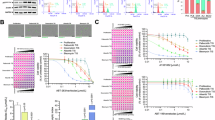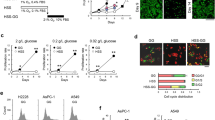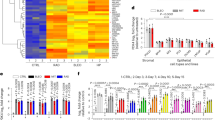Abstract
Pseudolaric acid B (PAB), a diterpene acid isolated from the root bark of Pseudolarix kaempferi Gordon, exerts anti-tumor effects in several cancer cell lines. Our previous study showed that PAB mainly induced senescence via p53-p21 activation rather than apoptosis in suppression of the growth of human lung cancer A549 cells (p53 wild-type). In p53-null human lung cancer H1299 cells, however, PAB caused apoptosis without senescence. In this study we investigated what mechanism was responsible for the switch from senescence to apoptosis in PAB-treated human lung cancer cell lines. Senescent cells were examined by SA-β-gal staining. Glucose uptake and the apoptosis ratio were assessed using a FACScan flow cytometer. Commercial assay kits were used to measure the levels of ATP and lactate. Transfection of siRNA was used to knockdown the expression of p53 or p21. Western blot analysis was applied to measure the protein expression levels. In p53 wild-type A549 cells, PAB (20 μmol/L) caused senescence, and time-dependently increased glucose utilization; knockdown of p53 or p21 significantly decreased the uptake and metabolism of glucose but elevated PAB-induced apoptosis. Inhibition of glucose utilization using a glycolytic inhibitor 2-DG (1 mmol/L) significantly enhanced apoptosis induction. Similar results were observed in another p53 wild-type H460 cells treated with PAB. Opposite results were found in p53-null H1299 cells, where PAB time-dependently decreased glucose utilization, and induced only apoptosis. Our results demonstrate that PAB-induced senescence is associated with enhanced glucose utilization, and lower glucose utilization might contribute to apoptosis induction. Thus, blocking glucose utilization contributes to the switch from senescence to apoptosis, and p53 plays an important role in this process.
Similar content being viewed by others

Log in or create a free account to read this content
Gain free access to this article, as well as selected content from this journal and more on nature.com
or
References
Warburg O . On the origin of cancer cells. Science 1956; 123: 309–14.
Pfeiffer T, Schuster S, Bonhoeffer S . Cooperation and competition in the evolution of ATP-producing pathways. Science 2001; 292: 504–7.
Garcia-Jimenez C, Garcia-Martinez JM, Chocarro-Calvo A, De la Vieja A . A new link between diabetes and cancer: enhanced WNT/beta-catenin signaling by high glucose. J Mol Endocrinol 2014; 52: R51–66.
Upadhyay M, Samal J, Kandpal M, Singh OV, Vivekanandan P . The Warburg effect: insights from the past decade. Pharmacol Ther 2013; 137: 318–30.
Hanahan D, Weinberg RA . The hallmarks of cancer. Cell 2000; 100: 57–70.
Flier JS, Mueckler MM, Usher P, Lodish HF . Elevated levels of glucose transport and transporter messenger RNA are induced by ras or src oncogenes. Science 1987; 235: 1492–5.
Pelicano H, Martin DS, Xu RH, Huang P . Glycolysis inhibition for anticancer treatment. Oncogene 2006; 25: 4633–46.
Liao EC, Hsu YT, Chuah QY, Lee YJ, Hu JY, Huang TC, et al. Radiation induces senescence and a bystander effect through metabolic alterations. Cell Death Dis 2014; 5: e1255.
Christofk HR, Vander Heiden MG, Harris MH, Ramanathan A, Gerszten RE, Wei R, et al. The M2 splice isoform of pyruvate kinase is important for cancer metabolism and tumour growth. Nature 2008; 452: 230–3.
Yan Z, Hua H, Xu Y, Samaranayake LP . Potent antifungal activity of pure compounds from traditional Chinese medicine extracts against six oral Candida species and the synergy with fluconazole against azole-resistant Candida albicans. Evid Based Complement Alternat Med 2012; 2012: 106583.
Yu JH, Cui Q, Jiang YY, Yang W, Tashiro S, Onodera S, et al. Pseudolaric acid B induces apoptosis, senescence, and mitotic arrest in human breast cancer MCF-7. Acta Pharmacol Sin 2007; 28: 1975–83.
Meng AG, Jiang LL . Induction of G2/M arrest by pseudolaric acid B is mediated by activation of the ATM signaling pathway. Acta Pharmacol Sin 2009; 30: 442–50.
Yao G, Qi M, Ji X, Fan S, Xu L, Hayashi T, et al. ATM-p53 pathway causes G2/M arrest, but represses apoptosis in pseudolaric acid B-treated HeLa cells. Arch Biochem Biophys 2014; 558: 51–60.
Qi M, Fan S, Yao G, Li Z, Zhou H, Tashiro S, et al. Pseudolaric acid B-induced autophagy contributes to senescence via enhancement of ROS generation and mitochondrial dysfunction in murine fibrosarcoma L929 cells. J Pharmacol Sci 2013; 121: 200–11.
Yao GD, Yang J, Li Q, Zhang Y, Qi M, Fan SM, et al. Activation of p53 contributes to pseudolaric acid B-induced senescence in human lung cancer cells in vitro. Acta Pharmacol Sin 2016; 37: 919–29.
Cahu J, Bustany S, Sola B . Senescence-associated secretory phenotype favors the emergence of cancer stem-like cells. Cell Death Dis 2012; 3: e446.
Coppe JP, Desprez PY, Krtolica A, Campisi J . The senescence-associated secretory phenotype: the dark side of tumor suppression. Annu Rev Pathol 2010; 5: 99–118.
Ghobrial IM, Witzig TE, Adjei AA . Targeting apoptosis pathways in cancer therapy. CA Cancer J Clin 2005; 55: 178–94.
Campisi J . Aging, cellular senescence, and cancer. Annu Rev Physiol 2013; 75: 685–705.
Dorr JR, Yu Y, Milanovic M, Beuster G, Zasada C, Dabritz JH, et al. Synthetic lethal metabolic targeting of cellular senescence in cancer therapy. Nature 2013; 501: 421–5.
Goldsmith J, Levine B, Debnath J . Autophagy and cancer metabolism. Methods Enzymol 2014; 542: 25–57.
Zhang JW, Zhang SS, Song JR, Sun K, Zong C, Zhao QD, et al. Autophagy inhibition switches low-dose camptothecin-induced premature senescence to apoptosis in human colorectal cancer cells. Biochem Pharmacol 2014; 90: 265–75.
Gao C, Yan X, Wang B, Yu L, Han J, Li D, et al. Jolkinolide B induces apoptosis and inhibits tumor growth in mouse melanoma B16F10 cells by altering glycolysis. Sci Rep 2016; 6: 36114.
Jones RG, Plas DR, Kubek S, Buzzai M, Mu J, Xu Y, et al. AMP-activated protein kinase induces a p53-dependent metabolic checkpoint. Mol Cell 2005; 18: 283–93.
Menendez JA, Oliveras-Ferraros C, Cufi S, Corominas-Faja B, Joven J, Martin-Castillo B, et al. Metformin is synthetically lethal with glucose withdrawal in cancer cells. Cell Cycle 2012; 11: 2782–92.
del Nogal M, Troyano N, Calleros L, Griera M, Rodriguez-Puyol M, Rodriguez-Puyol D, et al. Hyperosmolarity induced by high glucose promotes senescence in human glomerular mesangial cells. Int J Biochem Cell Biol 2014; 54: 98–110.
E S, Kijima R, Honma T, Yamamoto K, Hatakeyama Y, Kitano Y, et al. 1-Deoxynojirimycin attenuates high glucose-accelerated senescence in human umbilical vein endothelial cells. Exp Gerontol 2014; 55: 63–9.
Yuneva M, Zamboni N, Oefner P, Sachidanandam R, Lazebnik Y . Deficiency in glutamine but not glucose induces MYC-dependent apoptosis in human cells. J Cell Biol 2007; 178: 93–105.
Hardie DG, Scott JW, Pan DA, Hudson ER . Management of cellular energy by the AMP-activated protein kinase system. FEBS Lett 2003; 546: 113–20.
Blagih J, Krawczyk CM, Jones RG . LKB1 and AMPK: central regulators of lymphocyte metabolism and function. Immunol Rev 2012; 249: 59–71.
Rehman G, Shehzad A, Khan AL, Hamayun M . Role of AMP-activated protein kinase in cancer therapy. Arch Pharm (Weinheim) 2014; 347: 457–68.
Izyumov DS, Avetisyan AV, Pletjushkina OY, Sakharov DV, Wirtz KW, Chernyak BV, et al. "Wages of fear": transient threefold decrease in intracellular ATP level imposes apoptosis. Biochim Biophys Acta 2004; 1658: 141–7.
Xu RH, Pelicano H, Zhou Y, Carew JS, Feng L, Bhalla KN, et al. Inhibition of glycolysis in cancer cells: a novel strategy to overcome drug resistance associated with mitochondrial respiratory defect and hypoxia. Cancer Res 2005; 65: 613–21.
Sols A, Crane RK . The inhibition of brain hexokinase by adenosinediphosphate and sulfhydryl reagents. J Biol Chem 1954; 206: 925–36.
Vuyyuri SB, Rinkinen J, Worden E, Shim H, Lee S, Davis KR . Ascorbic acid and a cytostatic inhibitor of glycolysis synergistically induce apoptosis in non-small cell lung cancer cells. PLoS One 2013; 8: e67081.
Mi YJ, Geng GJ, Zou ZZ, Gao J, Luo XY, Liu Y, et al. Dihydroartemisinin inhibits glucose uptake and cooperates with glycolysis inhibitor to induce apoptosis in non-small cell lung carcinoma cells. PLoS One 2015; 10: e0120426.
Schmitt CA, Fridman JS, Yang M, Lee S, Baranov E, Hoffman RM, et al. A senescence program controlled by p53 and p16INK4a contributes to the outcome of cancer therapy. Cell 2002; 109: 335–46.
Vogelstein B, Lane D, Levine AJ . Surfing the p53 network. Nature 2000; 408: 307–10.
Bensaad K, Tsuruta A, Selak MA, Vidal MN, Nakano K, Bartrons R, et al. TIGAR, a p53-inducible regulator of glycolysis and apoptosis. Cell 2006; 126: 107–20.
Jiang P, Du W, Wang X, Mancuso A, Gao X, Wu M, et al. p53 regulates biosynthesis through direct inactivation of glucose-6-phosphate dehydrogenase. Nat Cell Biol 2011; 13: 310–6.
Schwartzenberg-Bar-Yoseph F, Armoni M, Karnieli E . The tumor suppressor p53 down-regulates glucose transporters GLUT1 and GLUT4 gene expression. Cancer Res 2004; 64: 2627–33.
Vousden KH, Ryan KM . p53 and metabolism. Nat Rev Cancer 2009; 9: 691–700.
Maddocks OD, Vousden KH . Metabolic regulation by p53. J Mol Med (Berl) 2011; 89: 237–45.
Chang BD, Broude EV, Dokmanovic M, Zhu H, Ruth A, Xuan Y, et al. A senescence-like phenotype distinguishes tumor cells that undergo terminal proliferation arrest after exposure to anticancer agents. Cancer Res 1999; 59: 3761–7.
te Poele RH, Okorokov AL, Jardine L, Cummings J, Joel SP . DNA damage is able to induce senescence in tumor cells in vitro and in vivo. Cancer Res 2002; 62: 1876–83.
Ewald JA, Desotelle JA, Wilding G, Jarrard DF . Therapy-induced senescence in cancer. J Natl Cancer Inst 2010; 102: 1536–46.
Roninson IB . Tumor senescence as a determinant of drug response in vivo. Drug Resist Updat 2002; 5: 204–8.
Jackson JG, Pant V, Li Q, Chang LL, Quintas-Cardama A, Garza D, et al. p53-mediated senescence impairs the apoptotic response to chemotherapy and clinical outcome in breast cancer. Cancer Cell 2012; 21: 793–806.
Tonnessen-Murray CA, Lozano G, Jackson JG . The regulation of cellular functions by the p53 protein: cellular senescence. Cold Spring Harb Perspect Med 2017; 7.
Liu J, Zhang C, Hu W, Feng Z . Tumor suppressor p53 and its mutants in cancer metabolism. Cancer Lett 2015; 356: 197–203.
Zhou G, Wang J, Zhao M, Xie TX, Tanaka N, Sano D, et al. Gain-of-function mutant p53 promotes cell growth and cancer cell metabolism via inhibition of AMPK activation. Mol Cell 2014; 54: 960–74.
Parrales A, Iwakuma T . p53 as a regulator of lipid metabolism in cancer. Int J Mol Sci 2016; 17.
Yao Z, Xie F, Li M, Liang Z, Xu W, Yang J, et al. Oridonin induces autophagy via inhibition of glucose metabolism in p53-mutated colorectal cancer cells. Cell Death Dis 2017; 8: e2633.
Author information
Authors and Affiliations
Corresponding author
Rights and permissions
About this article
Cite this article
Yao, Gd., Yang, J., Li, Xx. et al. Blocking the utilization of glucose induces the switch from senescence to apoptosis in pseudolaric acid B-treated human lung cancer cells in vitro. Acta Pharmacol Sin 38, 1401–1411 (2017). https://doi.org/10.1038/aps.2017.39
Received:
Accepted:
Published:
Issue date:
DOI: https://doi.org/10.1038/aps.2017.39
Keywords
This article is cited by
-
Plant-derived terpenoids modulating cancer cell metabolism and cross-linked signaling pathways: an updated reviews
Naunyn-Schmiedeberg's Archives of Pharmacology (2025)
-
p63 affects distinct metabolic pathways during keratinocyte senescence, evaluated by metabolomic profile and gene expression analysis
Cell Death & Disease (2024)


